10 Proven Ways to Rank on Google Without Backlinks in 2024
Say goodbye to tired link-building strategies that hurt your reputation. Learn how to rank on Google with outreach with these SEO tips.
 June 22, 2023
June 22, 2023 15 minute reading
15 minute reading
If you’re anything like me, link building makes you cringe. I hate digging up random email addresses and creating “personalized” outreach messages begging for backlinks.
After a few failed attempts, I knew I needed to find a way around link building.
This is my complete guide to SEO without backlinks. Using the below strategies is one of the main ways I’ve gotten one URL to more than 3.9 million clicks in the last 16 months—without a second spent on link building.
So if you want to rank your online content without link building, this list is for you.
10 ways to rank without backlinks in 2023
1. Start with an expert writer
An expert writer is not going to give you a killer draft. They will also help you rank without building backlinks. Why?
Four letters: E-E-A-T (experience, expertise, authoritativeness, and trustworthiness).
E-E-A-T is part of Google’s Search Quality Rater Guidelines. It’s the playbook people use to evaluate the quality of search results. Quality Raters give Google feedback to help the algorithm provide better results.
At the heart of this concept is trust.

Source: Search Quality Rater Guidelines
Working with authors who have firsthand experience with a topic improves trust with readers. And it can lead to more conversions on your website, which can also signal to Google that your site is credible.
So, what do you look for when searching for this expert writer? Let’s apply the E-E-A-T principle:
Experience
The writer has firsthand experience with the subject matter. This proves that their suggestions are tried and true. For example, a writer can speak from personal experience and show photos that prove it.
Expertise
Quality Raters also look at a writer’s topical expertise. Do they have the knowledge and qualifications to offer reliable information?
Expertise and experience are similar, but they’re not the same thing. Think of the topic of investing. People will want advice from an accredited professional. That’s expertise.
This article from Investopedia is written by an expert trader, James Chen. It’s clear he knows about stocks, given that he is a Chartered Market Technician (CMT), as stated in his profile.
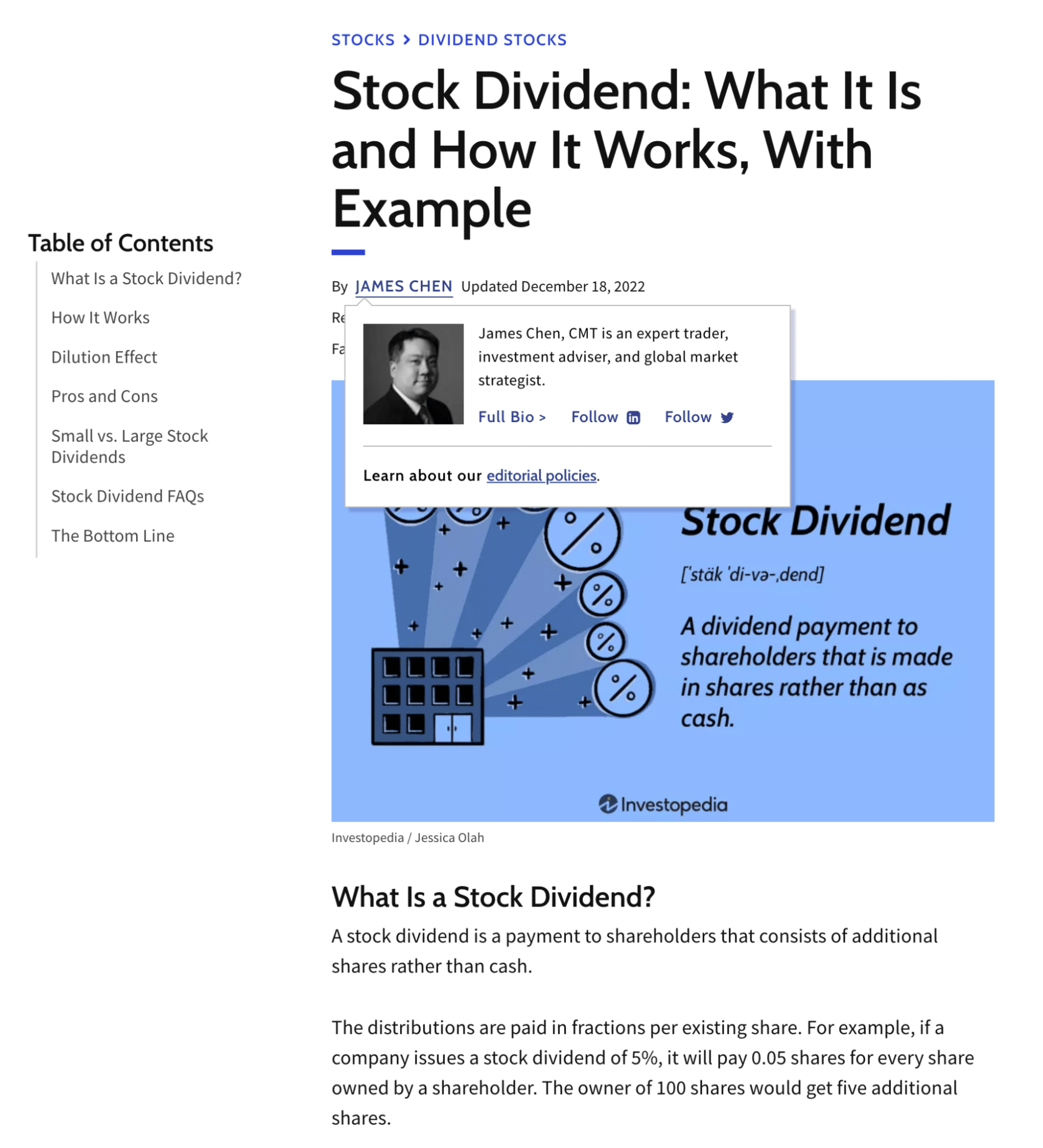
Authoritativeness
Authoritativeness refers to the writer’s reputation in their industry. Quality Raters have to look at the creator, the content, and the website to determine authority.
With the stock dividends article above, Investopedia is credible because:
Investopedia is a reputable website for investing advice
The authors are trading professionals
Two experts review and fact check the content for accuracy
Writers who are authoritative are seen as a good source of information. This can help you rank higher in search engines without doing link building.
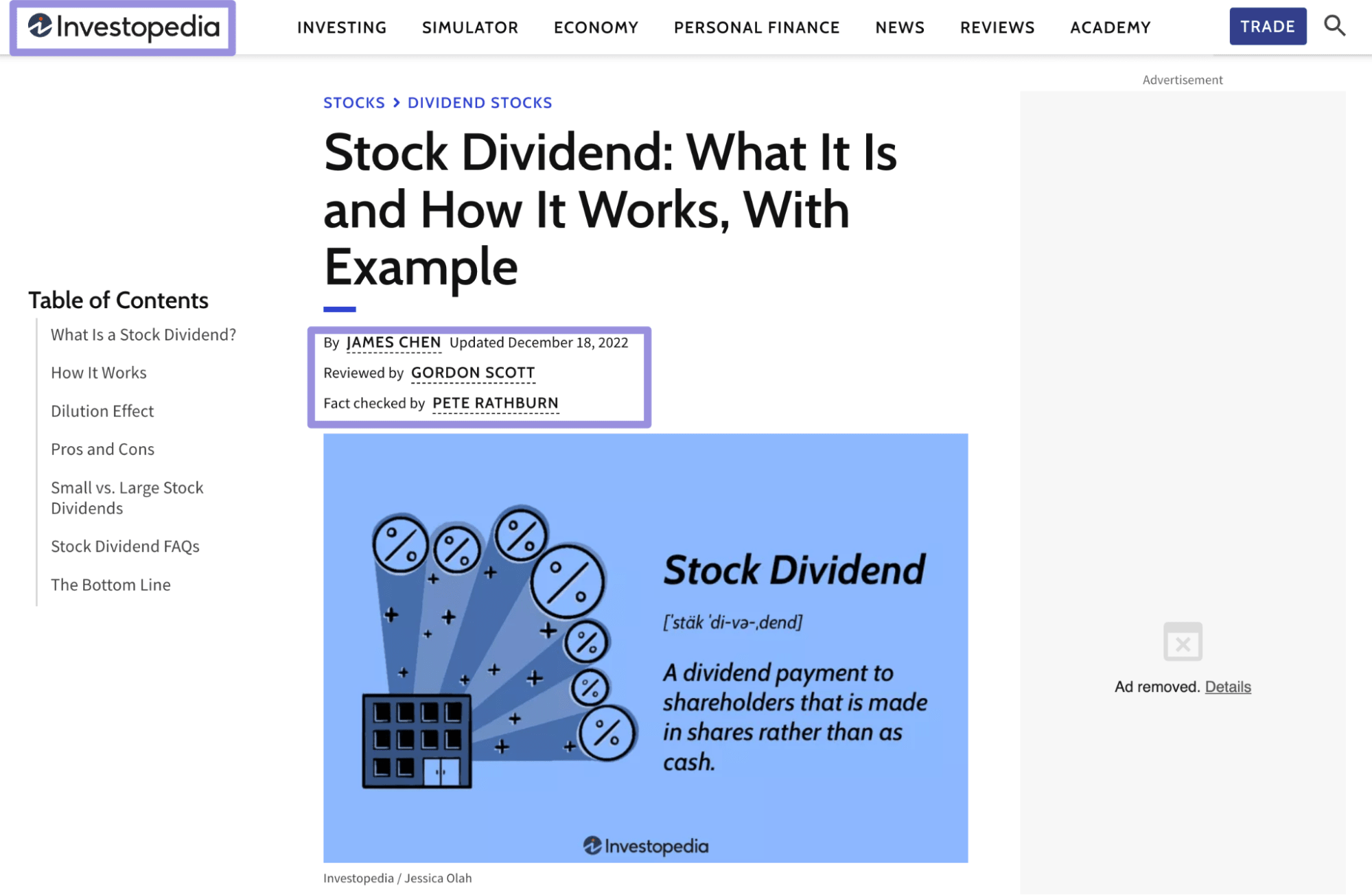
Trustworthiness
Being trustworthy is the most important part of E-E-A-T. Quality Raters will take the writer and website into account to determine trustworthiness.
Be open about who wrote and reviewed your content, edit for accuracy, cite your sources, and don’t hide content behind ads.
When searching for a writer on Fiverr, you can figure out trustworthiness by looking at their stats. Say you’re looking at @laurenmeikle’s profile.
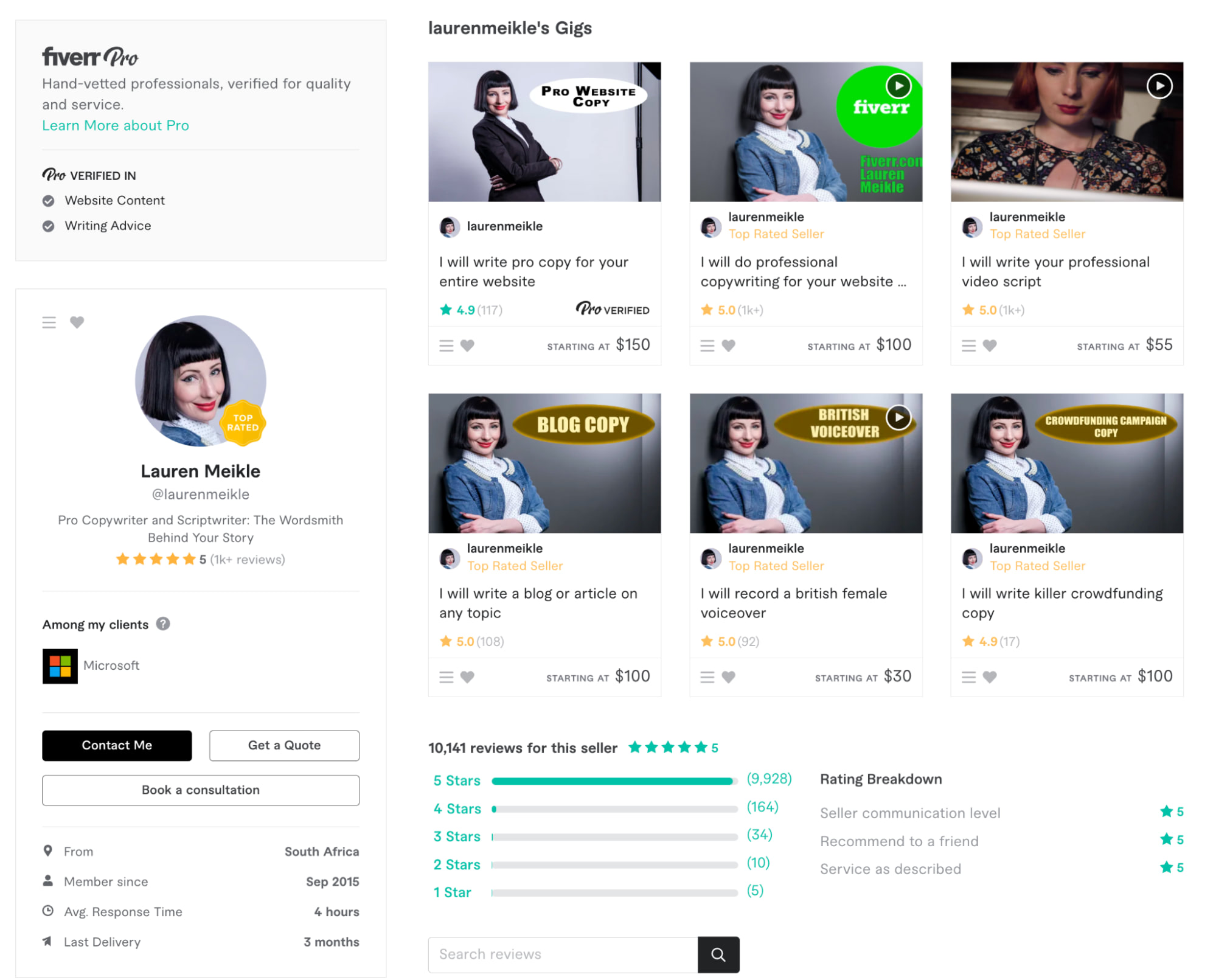
There are a few key indicators that Lauren will be a great asset to your team:
She is hand-vetted by Fiverr.
She has a 5-star rating, with over 1,000 reviews.
She has worked with reputable brands like Microsoft.
Search for a writer by niche. For example, if you need content about TikTok, hire an expert writer with TikTok experience.
Starting with a credible writer is just the first step.
2. Go for low competition, long-tail keywords
Low competition keywords are search queries that have fewer websites trying to rank for them. They are great for ranking without backlinks because, well, they’re easier to rank for.
There is an idealized version of “high search volume, low competition” keywords. But these are extremely rare to come by.
The goal here is to find low competition keywords within your niche. As you rank for more of them, you can build credibility and eventually rank for tougher keywords.
That’s how we kicked off Peak Freelance’s blog in June 2021. We started going for the reachable keywords with our small domain, starting out with just two sessions a day from organic search.
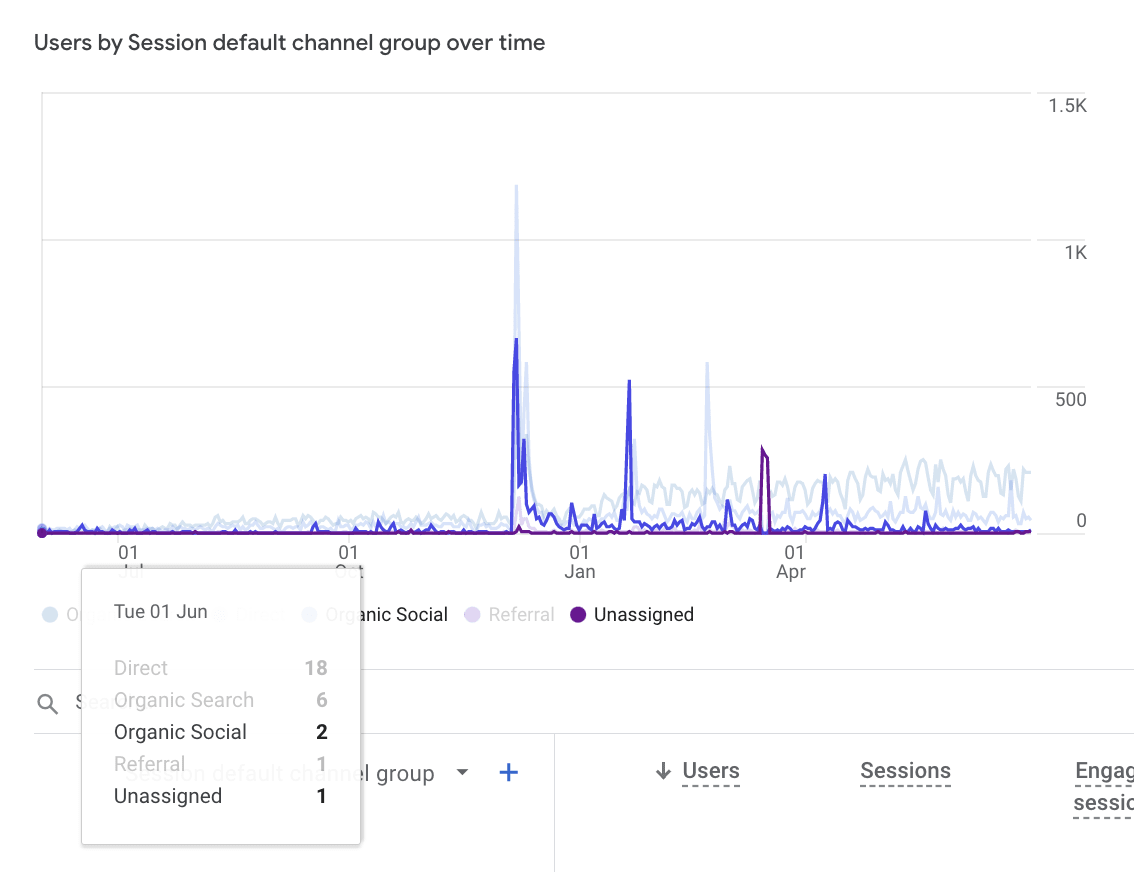
By December, we were starting to see more spikes in traffic. We’d grab a snippet here or there, or rank in position #1 for a target keyword.

So, how do you find these low-hanging-fruit keywords to go after? By using an SEO tool like Semrush or Ahrefs.
For this case, we’ll use Semrush’s Keyword Magic Tool. Enter a term that you want to rank for. We’ll use “freelance writing.” Then use the Related filter to find related keywords.
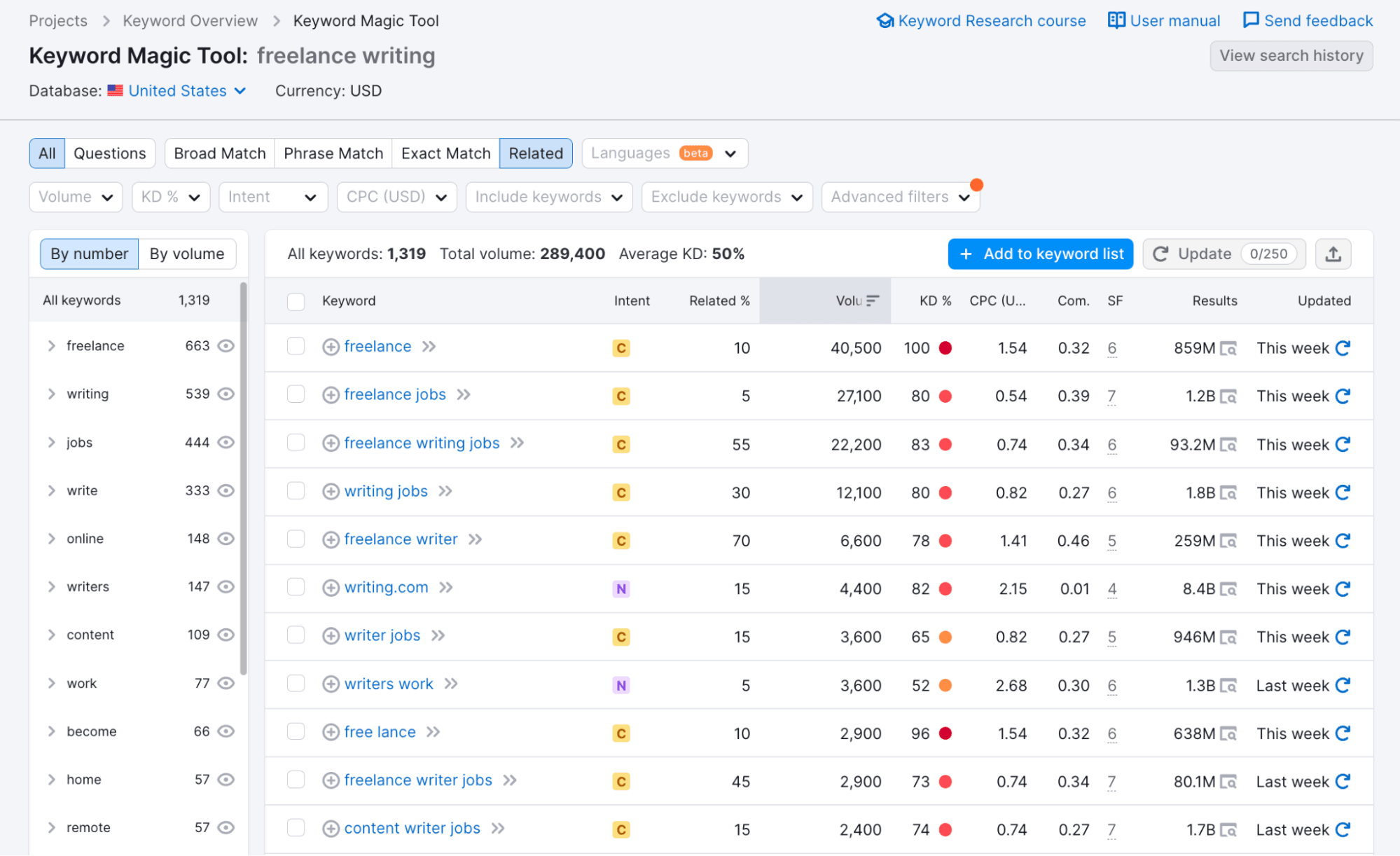
This lists the phrases semantically related to your core keyword. These are still looking a bit too high, according to Semrush’s Keyword Difficulty (KD%) rating. KD% is just how Semrush measures the difficulty of the keyword you’re going after.
Next, you’re going to click the KD% filter on the screen.

Then choose the type of keywords you want to go after. You can select “Very easy” or “Easy” to start, or input a custom range.
I use the custom range 0-30%.
After clicking Apply, you can see your new list of low-hanging-fruit keywords.
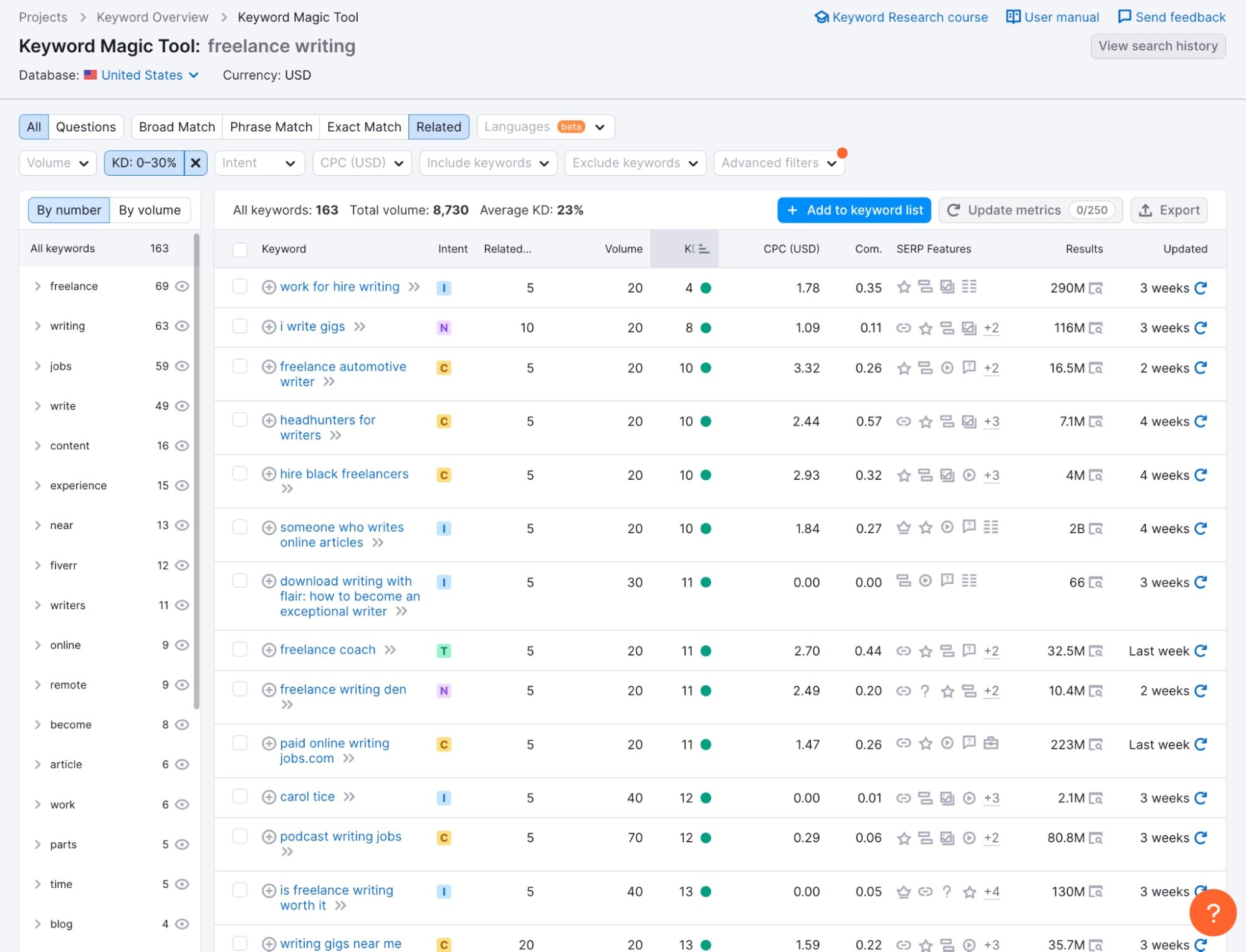
Right off the bat, there are some excellent keywords to choose from as a new website:
Is freelance writing worth it (40 MSV)
Freelance writing coach (20 MSV)
Podcast writing jobs (70 MSV)
Article writing jobs (390 MSV)
Freelance writer job description (210 MSV)
If you’re building a new freelance writing site, these are a few great options to explore. There are plenty of other AI tools to build out your SEO strategy, too.
Are you not an SEO guy, gal, or pal? No sweat. You can work find professional freelance SEO services on Fiverr to help find you low competition keywords for the site.
3. Create valuable content
You’ve got your expert writer and your list of juicy keywords to go after. Now the fun part: creating the content to rank.
Well-researched, well-written, and optimized content is key. Search engines aim to prove the best possible results for users.
If your content provides valuable information, people are more likely to:
Stay on your page longer
Share your content
Return to your site
This tells Google, “Yes, that website is high quality and we should rank it higher!”
Ashley R. Cummings, a search-focused writer and reporter, explains, “When your content closely matches what people are looking for, search engines are more likely to rank your content highly.”
Cummings says search engines “prefer thorough content that covers a topic and solves a problem. Informational content, which helps readers answer questions, is often in-depth, which is a strong ranking signal for search engines.”
But how do you actually create valuable content? Here’s a checklist to guarantee you’re only producing rich, interesting articles:
Answer reader’s questions about a topic. Use tools like Google’s People Also Ask box or AnswerThePublic to identify questions about your topic. Then, incorporate well-researched answers into your article.
Find unique facts and data points. Whether it’s unique statistics, historical facts, or lesser-known aspects of your topic, these details can add depth and richness to your content.
Look into research studies. Citing research studies can give your content credibility and depth. Look for recent studies from reputable sources that are relevant to your topic. Summarize the findings in a way that’s easy for your readers to understand and apply.
Interview experts in the space. Experts can provide insights that are not readily available elsewhere. Reach out to industry leaders for an interview or quote on LinkedIn or via email. Their perspectives can add authority to your content and offer unique value to your readers.
Find snippets on Twitter. Twitter is a great source for real-time information and expert insights. Look for tweets from industry leaders or discussions around your topic. Embedding relevant tweets in your content can make it more timely and engaging.
Include information from industry newsletters. Industry newsletters often contain valuable insights that aren’t found in mainstream sources. If you subscribe to these newsletters, you can share relevant information with your readers, always giving proper credit.
Share case studies. Case studies provide real-world examples that can make your content more relatable and persuasive. Look for case studies that align with your topic and highlight the key takeaways. They can help illustrate points in a practical, concrete way.
Find good examples. Examples can make abstract concepts easier to understand. Whether you’re explaining a process, illustrating a principle, or debunking a myth, examples can bring your content to life. Look for examples that are relevant, clear, and compelling.
4. Tidy up your on-page SEO
Guarantee your on-page SEO is in shape before publishing the content. This may feel a little basic, but it’s a good idea to run through the following checklist, whether for a blog post or landing page:
Optimize your title tags: Your title tag is the first thing users and search engines see. It should be enticing and include your main keyword.
Use meta descriptions: Provide a brief summary of your page content. Make sure it’s appealing and includes your primary and secondary keywords.
Improve URL structure: Make URLs SEO-friendly—short, clean, and descriptive, and include the target keyword.
Use headings and subheadings: H1, H2, and H3 tags make your content easier to read and navigate. They also help search engine bots understand the structure of your content.
Optimize images: Use relevant images with optimized file sizes to improve page load times. Include descriptive file names and alt text for SEO and accessibility.
Use reputable external links: Linking to credible high authority sites can improve SEO and provide additional value to your readers.
5. Focus on internal linking
Internal linking refers to linking one page on your website to another. These links help guide visitors through your site and create a good user experience. They also help search engines understand the structure and hierarchy of it.
Think of your website as a house. Each page of your site is a room.
Internal links are the doors that let you move from one room to another. If you have a new room (page) but no doors (internal links) leading to it, your guests (users and search engines) will struggle to find and reach that room.
Here’s an example of a linking map I made a few years ago for a newer website.
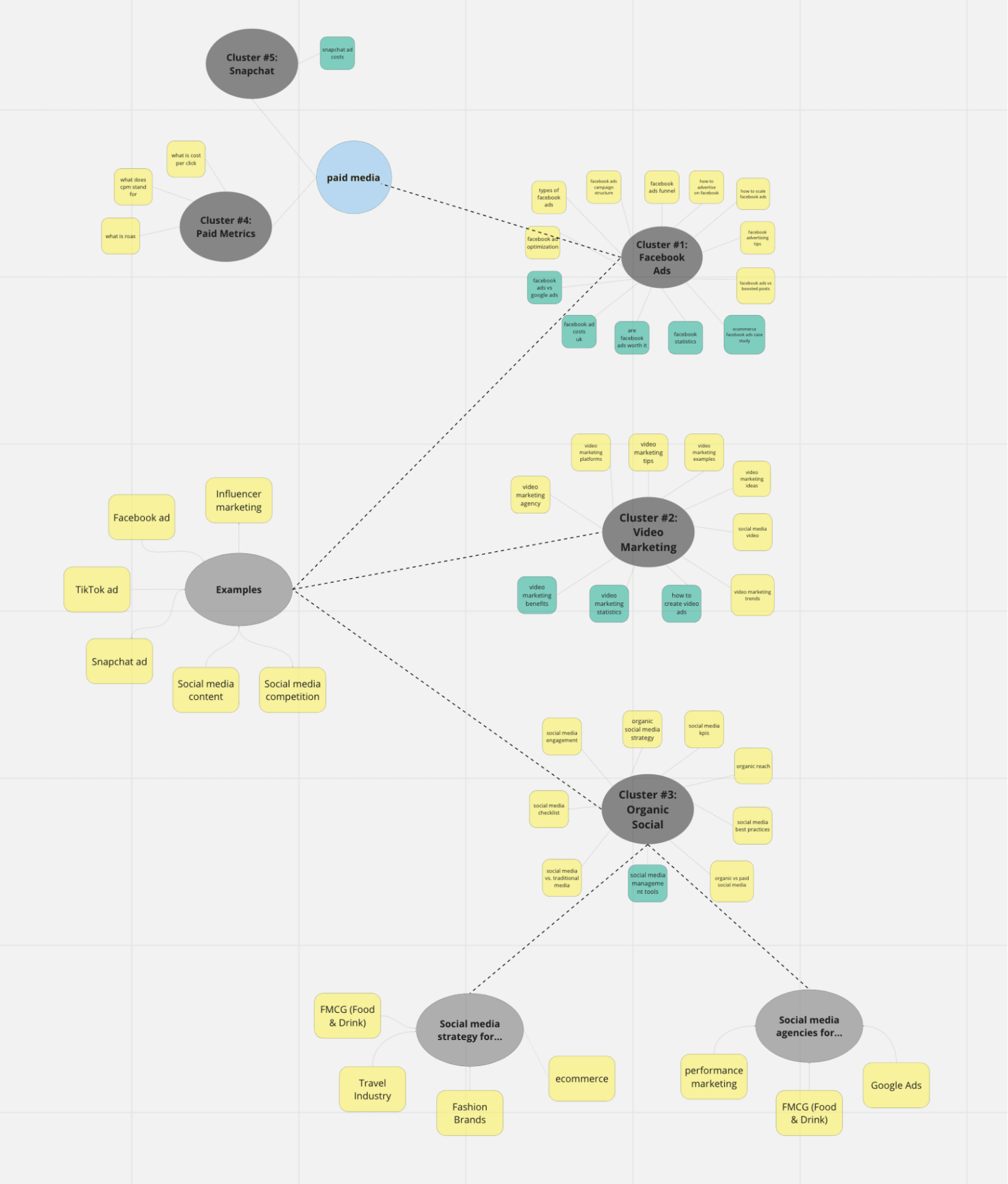
In short, the center gray bubbles were anchor pieces, or big guides. The yellow (new articles) and green (updated articles) would be interlinked between each other and the anchor guide.
The interlinking allows search engines to crawl and index your site more effectively. This improves your site’s visibility on the search engine results page (SERP).
Overall, if you’re creating really amazing content but don’t let Google know through internal linking, it’ll be tough to rank without external backlinks. 💡TAKE ACTION:
Use descriptive anchor text: The clickable text in a hyperlink is called anchor text. Make sure it’s descriptive and gives an idea about the linked page. This will give you some link juice and tell search engines what the page is about. Avoid over-optimization—using exact-match keywords excessively—which can look spammy to search engines.
Link deep: Rather than just interlinking your top-level pages (like home, About Us, Contact Us), make sure you’re linking deeper to individual blog posts, product pages, or service pages. These are typically the pages with unique, valuable content.
Use follow links: Ensure your internal links are "follow" links, meaning that search engines are allowed to follow them and pass link equity.
Create content consistently: The more valuable content you create, the more opportunities you have for internal linking.
🧠LEARN: Is WordPress or Shopify better for SEO? Experts Speak Out
6. Optimize each page with Clearscope
Clearscope is a keyword research and content optimization tool. Its main feature is helping you optimize webpages for search—and it works well.
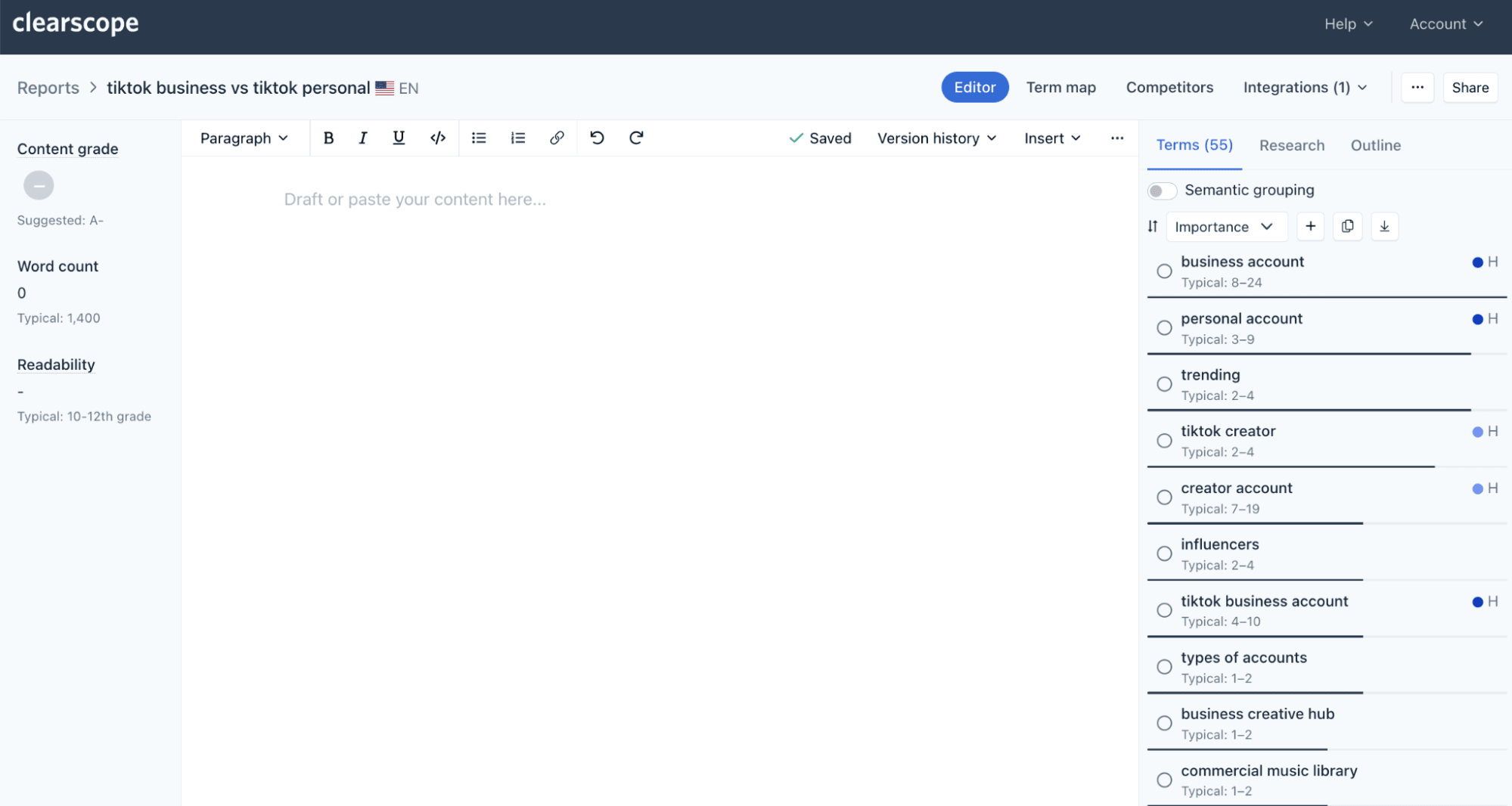
Clearscope grades your content based on content relevance and comprehensiveness. It scans your content for terms Google considers closely related to your target query.
Then, Clearscope gives you a letter grade based on how well your content is optimized.
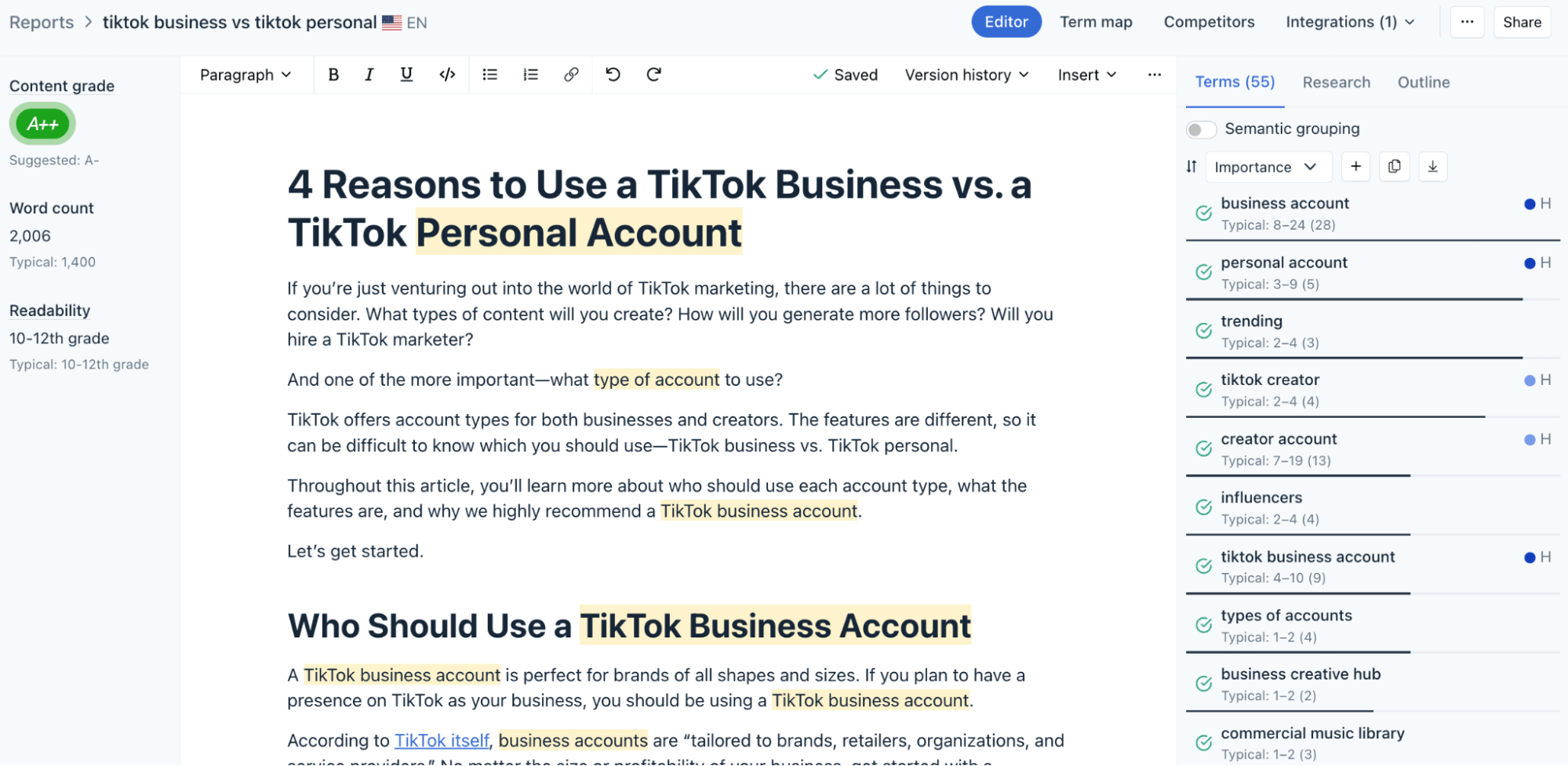
Clearscope is also so easy to use. When you login to Clearscope, you end up on the dashboard page. It’s here you run reports.

Simply type in a keyword you want to rank for. Then click “Run report.” When the report is done, you can open the report and enter your content, as seen above.
Use Clearscope to optimize any webpage: blogs, product pages, and landing pages are a few I’ve tried and ranked—all without getting quality backlinks.
7. Build research reports
Research reports are a secret SEO technique when it comes to ranking without link building. A research report refers to compiling, analyzing, and presenting data on a specific subject. It’s a fabulous asset for new sites because it’s original and authoritative—two things Google likes.
When we launched Peak Freelance’s first writing rates report in December 2021, we didn’t even optimize the report for search engines, and by January 2022, we were already seeing the URL move onto first page for various keywords.

We were the first brand to jump on the research report, plus publications and related blogs started quoting our research in their articles. All we did was launch the final report on Twitter and tell our email newsletter about it.
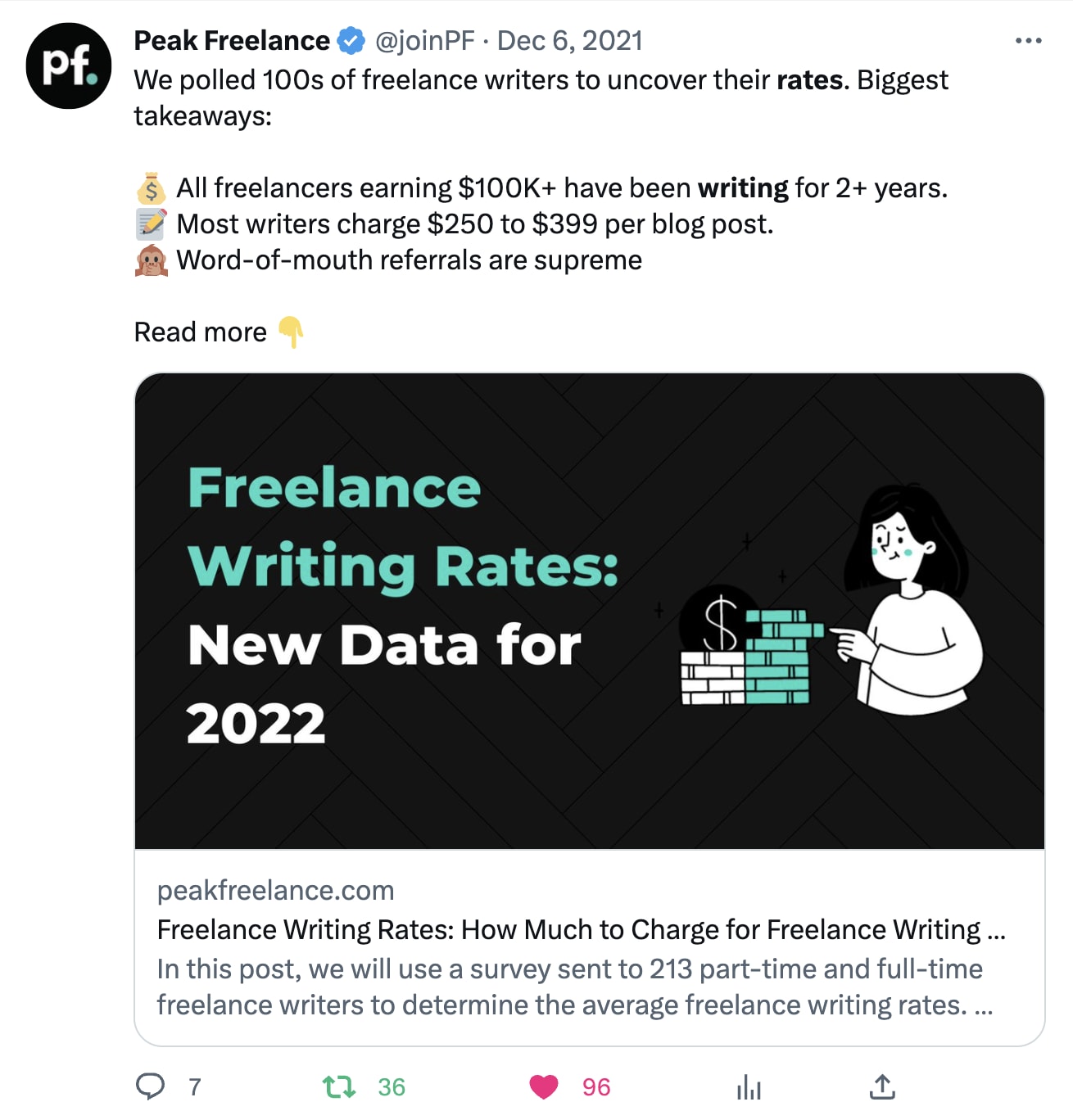
8. Distribute new content
When publishing on a new site with low domain authority, you have to get eyeballs on your content somehow. Distribution involves promoting and sharing your content across various channels to reach a larger audience.
From an SEO perspective, it helps bring more visitors to your site. The more people who engage with your content, the better credibility signals you’ll send to Google Search.
“Manually building backlinks isn’t necessary to drive traffic or rank,” says Tyler Hakes, founder of content marketing agency Optimist. “Sharing quality content around places where your audience hangs out is key.”
Channels that work well, in Hakes experience, are:
Reddit
Hacker News
Targeted newsletters
Industry roundups
Targeted placements
YouTube
“Social media can work if you have an audience,” he adds, “But if you don’t, try to borrow an audience from someone else!”
As you distribute content through other channels, be sure to repurpose it. Hakes often repurposes blog posts into the following formats, like infographics and webinars.
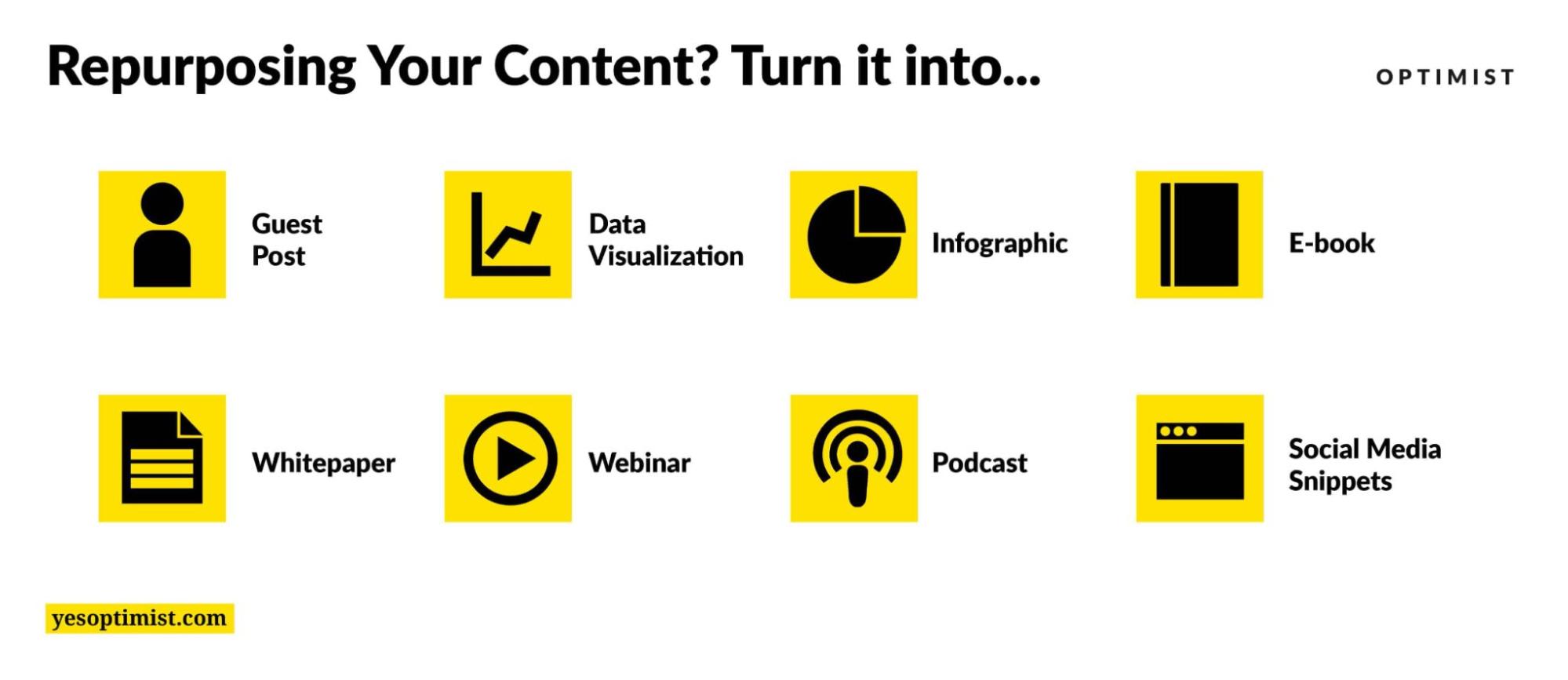
9. Tweak for click-through rate (CTR)
CTR is a metric that looks at the percentage of people who click on your link after seeing it in search engine results. A high CTR means people find your link relevant and interesting, which tells Google you’re worthy of higher placement.
Here are a few practical strategies to maximize your CTR:
Improve your title tags: Make sure your title tag is enticing, relevant, and includes your target keyword. Use numbers, special characters, or emotional adjectives to make it more appealing.
Create optimized meta descriptions: Your meta description should provide a concise and enticing summary of what users can expect if they click on your link. Including a clear value proposition can help encourage clicks.
Use structured data: This can help enhance your search listings with “rich snippets,” which can include things like ratings, images, or prices. These can make your link more eye-catching and informative, which can increase your CTR.
Improve your page speed:
If your page takes too long to load, visitors might abandon it before they even see your content, which can hurt your CTR. Use Google’s PageSpeed Insights checker to identify any issues with your page speed and get suggestions for improvement.
10. Update underperforming content
Got a URL (or a few) that’s hanging around on page 2? Updating underperforming content involves taking those pieces (which could be underperforming in terms of organic traffic, engagement, or conversions) and improving on the content.
Content updating is a smart way to improve your Google rankings, as it takes less time and resources than creating new content from scratch. “Freshness” is also a page ranking factor. The Google algorithm aims to provide the latest information for keywords.
While I could write an entire book on updating content, I’ll give you the overview and a few resources toward the end of this section. Regular updates are crucial to maintaining blog performance without building backlinks.
The screenshot below shows the results of two massive update projects. Over one year, we updated 10 landing pages and updated 100 URLs to go from near 0 clicks to 6.24 million.

I can’t stress it enough: Always be updating your content.
Here’s how to update content:
Identify underperforming content: Use Databox’s Decaying Site Pages & Posts (it’s free) databoard template to identify content that isn’t performing well. This includes content that’s dropped in sessions and ranking.
Analyze the issue: Understand why the content is underperforming. It might be outdated, off-topic, missing search intent, poorly written, too short, or lacking in SEO optimization. Or, there could be technical issues like slow page load times or broken links.
Revise and improve: Based on your analysis, revise and improve your content. Update outdated information, expand on underdeveloped points, improve the writing quality, optimize for SEO, and fix technical issues. Hire a Technical SEO specialist on Fiverr if you need the extra help.
Promote your updated content: Once you’ve updated your content, make sure to promote it. This might involve sharing it on social media, featuring it in your email newsletter, or using other promotional strategies.
For a step-by-step look at updating a URL, read How to Write a Roundup Post Worth $306K Per Month.
Working with freelancers on your content
Whether you’re a solo business owner or a thriving digital marketing team, you don’t have to work on SEO alone. Freelancers can help create timely, clickable content that improves keyword rankings. They can also help you find new keyword ideas and take your SEO strategy to the next level.
Fiverr offers a large marketplace of freelance SEO experts. You can use Fiverr’s chat system to talk to sellers before you hire them. Plus, use a single dashboard to manage people, places, and project files—all for no monthly charge.
Sound good? Sign up for a free Fiverr account today to start.



